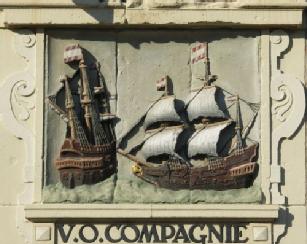The East India Companies
1. Lecture
Why did the Dutch, English, French and other European companies wish to engage in the trade with Asia? And why didn’t Chinese or Indian merchants do the same with Europe? How were companies structured? What were their organisation and aims? Did they compete with local merchants? What was the role of silver in this Eurasian trade? What commodities were exchanged?
Podcast
2. Seminar
- Did the European companies change the structure and size of world trade after 1500?
- Did European traders replace Asian traders in the Indian Ocean after 1600?
- Why were the European companies so successful? Consider the role of internal organisation, technical know-how and competition.
3. Core Readings
- de Vries, Jan, ‘Connecting Europe and Asia: A Quantitative Analysis of the Cape-Route Trade, 1497-1795’, in Dennis O’Flynn, Arturo Giràldez and Richard von Glahn, eds., Global Connections and Monetary History, 1470-1800 (Aldeshot, 2003), pp. 35-106.
- Marshall, P.J., ‘The British in Asia: Trade to Dominion, 1700- 1765’, in P.J. Marshall, The Eighteenth Century. The Oxford History of the British Empire, Vol. II, pp. 487-508 – also in H.V. Bowen, ‘British India:, 1765-1813: the Metropolitan Context’, pp. 530-551 [DA 16.O9] Copy of this in the Short Loan Collection
4. Essay Questions
- How successful were European Companies in organising long-distance sea trade?
- Where the early modern sea routes completely dominated by European merchants?
- Compare the role of two European trading Companies in Asia.
5. Further Readings
- Blussé, Leonard, and Gaastra, Femme (eds.), Companies and Trade, Leiden 1981.
- Bowen, H.V. et al., The Worlds of the East India Company (2002).
- Boxer, C.R., Fidalgos in the Far East (1968).
- Chaudhuri, K.N., Trade and Civilisation in the Indian Ocean (1985), chs. 4 and 10.
- Chaudhury, Sushil and Michel Morineau, Merchants, Companies and Trade. Europe and Asia in the Early Modern Era (Cambridge, 1999).
- Curtin, P.J., Cross-Cultural Trade in World History (Cambridge, 1984).
- Emmer, P. and F. Gaastra, eds., The Organization of Interoceanic Trade in European Expansion 1450-1800 (1996).
- George D. Winius & Marcus P.M. Vink, The Merchant-Warrior Pacified. The VOC (Dutch East India Co.) and its Changing Political Economy in India (Delhi and Oxford, 1991).
- Lawson, Philip. The East India Company: A History (London, 1993).
- Marshall, P.J., ‘The English in Asia’, in N. Canny, ed., The Origins of Empire. Oxford History of the British Empire, vol. 1 (Oxford, 1998), pp. 264-286 [DA 16.O9]
- Marshall, P.J., The Making and Unmaking of Empires (Oxford and New York, 2005), ch. 4 and 8 [DA 16.M2]
- Farrington Anthony, Trading Places: The East India Company and Asia 1600-1834 (London, 2002) [DS 465.F2
- The Navigator: The Log of John Anderson, VOC Pilot-Major, 1640-1643, edited by John Anderson, Victor Enthoven, et al.
European-Asian Trade
- Arbel, Benjamin, Trading Nations: Jews and Venetians in the Early Modern Eastern Mediterranean (Leiden, 1995).
- Chauduri, K.N., The Trading World of Asia and the English East India Company, 1660-1770 (Cambridge, 1978).
- Chauduri, K.N., Trade and Civilisation of the Indian Ocean: An Economic History from the Rise of Islam to 1750 (Cambridge, 1985).
- Chauduri, K.N., Asia Before Europe: Economy and Civilisation of the Indian Ocean from the Rise of Islam to 1750 (Cambridge, 1990).
- Findly, E.B., ‘The Capture of Maryam-uz-Zamani's Ship: Mughal Women and European Traders’, Journal of the American Oriental Society, 108, no. 2 (1988), pp. 227-238.
- Furber, Holden, Rival Empires of Trade in the Orient, 1600-1800 (Minneapolis, 1976).
- Masters, Bruce, The Origins of Western Economic Dominance in the Middle East: Mercantilism and the Islamic Economy in Aleppo, 1600-1750 (New York, 1988)
- Pearson, M.N., The World of the Indian Ocean, 1500-1800 (Ashgate, 2005).
- Prakash, Om, European Commercial Expansion in Early Modern Asia (Ashgate, 1997).
- Prakash, Om, European Commercial Enterprise in Pre-Colonial India (Cambridge 1998)
- Prakash, Om, ‘Financing the European Trade with Asia in the Early Modern Period: Dutch Initiatives and Innovations’, Journal of European Economic History, 27, no. 2 (1998).
- Rapp, Richard T., ‘The Unmaking of the Mediterranean Trade Hegemony: International Trade Rivalry and the Commercial Revolution’, Journal of Economic History, 35 (1975), pp. 499-525
- Steensgaard, Niels, Carracks, Caravans and Companies: The Structural Crisis in the European-Asian Trade of the Early Seventeenth Century (Copenhagen, 1973).
6. External Links
- Europe's Asian Centuries Project at Warwick
- The East India Company at Home, 1757-1857
- BBC Programme on the East India Company

